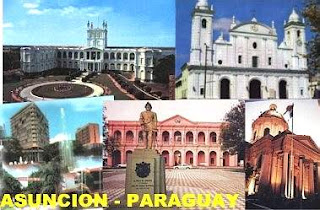CASE 455 - The history of paraguay
For much of the early history of the Spanish empire it is Asunción, rather than Buenos Aires, which is the colonial centre for the entire region south of Brazil. The first settlement at Buenos Aires is established in 1536. In 1537 colonists construct a stockade fort hundreds of miles up the Paraná and Paraguay rivers. Completing their work on Assumption Day, they call the place Asunción. In 1541 Buenos Aires succumbs to attacks from Indian tribes. The settlers at the mouth of the great river system abandon the site and escape upstream to Asunción. Almost forty years pass before colonists from Asunción return to the site of Buenos Aires and re-establish the town. Asunción has many advantages. Its longer continuous existence makes it the traditional centre of Spanish rule in the region. Economically it enjoys a commanding position in the interior, on the route leading up through the Andes into Peru. Yet it is also accessible by river from the Atlantic for ships drawing anything up to nine feet. This city becomes the starting point for Jesuit missionaries, as they press further into the interior to establish the famous reducciones of Paraguay. And it is subsequently the centre of growing colonial hostility to the missionaries, when their settlements become powerful - resulting eventually in armed raids on the missions and the expulsion of the Jesuits in 1767. A severe blow is struck to the pride of Asunción when its offspring city, Buenos Aires, is made in 1776 the capital of the new viceroyalty of La Plata. Resentment of the pretensions of the new capital is no doubt part of the reason why the citizens of Asunción refuse to join Buenos Aires in 1810 in its declaration of independence from Spain. An attempt at coercion by an Argentinian army under Manuel Belgrano only stiffens their resolve. However the Spanish governor of the province achieves what Belgrano cannot, when he enlists Portuguese help from Brazil against the Argentinians. This is too much for Asunción. In 1811 the colonists throw out the governor and declare their own independence as the republic of Paraguay.
A time of three caudíllos: 1814-1870
After a brief period of anarchy, the first of Paraguay's long series of caudíllos emerges. José Gaspar Rodríguez Francia is elected dictator in 1814 and three years later secures the office for life. Using his unlimited powers, he adopts a rigidly isolationist policy - treating Paraguay almost like a political microcosm, with himself playing the role of an 18th-century enlightened despot. He allows no contact or commerce with other nations, but within Paraguay he actively encourages agricultural and industrial improvements to make his isolated realm economically self-sufficient. An efficient army is built up to safeguard the frontiers. Though verging on madness, Francia's measures reflect to some extent the special nature of Paraguay. Ethnically it is a more homogeneous community than others in south America. The Spanish have always been a small minority here among the Guarani Indians, and from the start a mixing of the races is accepted as normal. By the 19th century nearly all Paraguayans are mestizos. After his death in 1840 there is a brief interim before a new dictator is securely established. Carlos Antonio López, coming to power in 1844, ends Francia's policy of isolationism but continues to strengthen the nation by promoting industry, building railways and providing the army with modern equipment and fortifications. The same programme is continued by Francisco Solano López, who seizes power on his father's death in 1862. He gives Paraguay a telegraph network, but his main passion is the army. He builds it up to a regular force of 60,000 men and he imports German officers to train them. But the possession of this strength tempts López into an adventure which is a disaster for Paraguay. Flexing his muscles, López picks a quarrel in 1864 with Brazil. The pretext is Brazilian intervention in a civil war in Uruguay. In response López marches north to capture the Brazilian town of Corumbá. Then, when refused permission to cross Argentinian territory for an invasion into southern Brazil, he responds by attacking the Argentinian town of Corrientes in April 1865. Amazingly López holds out against his powerful coalition of enemies for five years during the Civil war, but this is a terrible time for Paraguay. López's control becomes more tyrannical (in 1868 he executes several hundred citizens accused of joining in a plot against him) and the casualties of the war itself are appalling. As many as 300,000 people, rather more than half the population of the country, are calculated to have died during the five years of the conflict. Asunción is captured by the allies in 1869. López continues a guerrilla campaign until he is caught and shot by Brazilian troops in 1870. In the aftermath of the war Brazil and Argentina annexe large sections of Paraguay. Together they occupy the rest of the country until 1876.
Liberales and Colorados: 1870-1932
After the death of López in 1870 Paraguay acquires a constitution which remains, technically, the basis of political life in the nation until 1940. With the emergence of an electoral system, two parties are formed - the Liberales and the Colorados, reflecting the standard Liberal and conservative clash prevailing elsewhere at the time. In practice power rarely changes hands through the ballot box. Successive regimes result more often from coups and military intervention. Paraguay remains inward-loooking, concerned with its own tumultuous affairs. Not until the 1930s does the republic again become involved in a major international conflict. The issue is rivalry with neighbouring Bolivia over the Chaco region.
Read more: http://www.historyworld.net/wrldhis/PlainTextHistories.asp?ParagraphID=nuo#ixzz4SoaexC1h



No comments:
Post a Comment